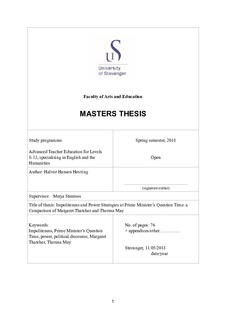| dc.contributor.advisor | Stenroos, Merja | |
| dc.contributor.author | Hansen, Halvor Høvring | |
| dc.date.accessioned | 2018-07-04T10:47:05Z | |
| dc.date.available | 2018-07-04T10:47:05Z | |
| dc.date.issued | 2018-05-11 | |
| dc.identifier.uri | http://hdl.handle.net/11250/2504318 | |
| dc.description | Master's thesis in Literacy Studies | nb_NO |
| dc.description.abstract | This thesis is a qualitative and quantitative study of impoliteness and power discourse strategies used during the weekly conversation between the UK Prime Minister and Parliament, known as Prime Minister’s Question Time or Prime Minister’s Questions (PMQs). The study compares the strategies used by the only two female Prime Ministers so far: the first ever female Prime Minister, Margaret Thatcher (1979-1990) and the current one, Theresa May (2016-).
The aim was to collect and classify all FTAs from a comparable number of PMQs sessions from both Prime Ministers studied, and then compare their impoliteness and power discourse strategies. The analysis was based on 75 sessions from Thatcher’s time as Prime Minister as well as the first 30 sessions from May’s time as Prime Minister. In the first instance, 60 and 30 sessions respectively were included, representing the same amount of time: when Thatcher was Prime Minister there were two 15-minute sessions each week, while today there is a single weekly 30-minute session. However, additional material was then added to permit a comparison between Margaret Thatcher’s sessions before and after the introduction of televising: the study therefore includes the final 15 sessions before the first televising of PMQs in 1989 in addition to the first 60 sessions after this. A very brief comparison with two male Prime Ministers, Tony Blair and David Cameron, was also made.
To point out what is bad about the Opposition was important to both Prime Ministers, and the majority of their responses were statements of fact. It is also clear that both Prime Ministers use their positions to remain in control during the sessions and they both speak very highly about their own policies as well as completely rejecting the policies of the Opposition.
In the age of extreme media coverage, May knows how to appeal to the audience and to capture their interest; her responses could be seen as intentionally more entertaining than Thatcher’s. As Thatcher was the Prime Minister in the first ever televised sessions of PMQs she was there from the beginning, before the Question Time had fully developed into the media event that it is now. This clearly had an influence on her responses: while they seem to have changed with televising, the great changes have taken place during the 29 years since the first televising. | nb_NO |
| dc.language.iso | eng | nb_NO |
| dc.publisher | University of Stavanger, Norway | nb_NO |
| dc.relation.ispartofseries | Masteroppgave/UIS-HF-IKS/2018; | |
| dc.subject | Prime Minister's Question Time | nb_NO |
| dc.subject | Margaret Thatcher | nb_NO |
| dc.subject | Theresa May | nb_NO |
| dc.subject | literacy studies | nb_NO |
| dc.subject | lesevitenskap | nb_NO |
| dc.subject | uhøflighet | nb_NO |
| dc.subject | politisk diskurs | nb_NO |
| dc.subject | britisk politikk | nb_NO |
| dc.title | Impoliteness and Power Strategies at Prime Minister's Question Time: a Comparison of Margaret Thatcher and Theresa May | nb_NO |
| dc.type | Master thesis | nb_NO |
| dc.subject.nsi | VDP::Humanities: 000::Literary disciplines: 040 | nb_NO |
